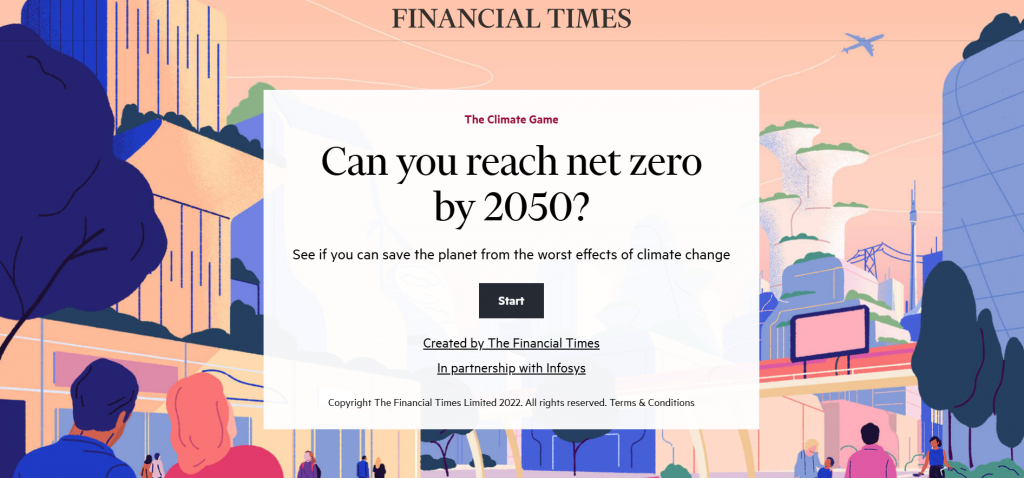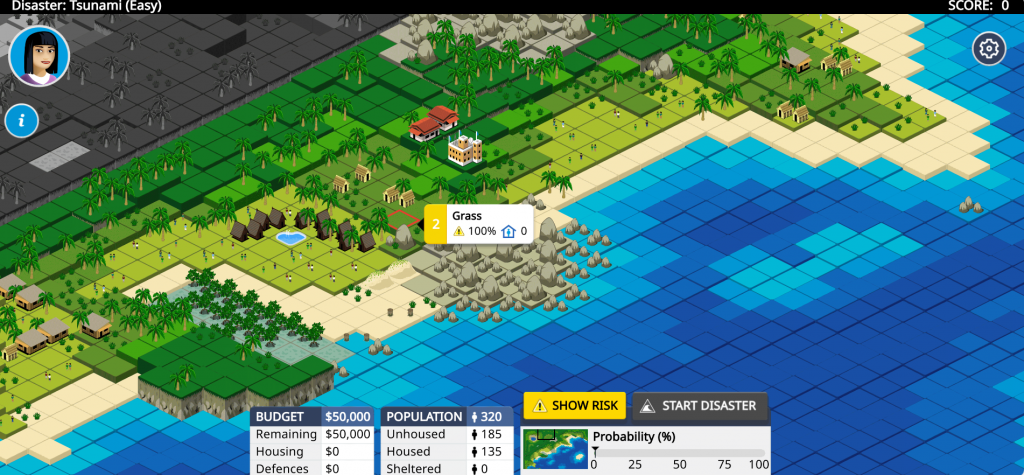During week 9 of 2025 the DecouplingIT project had an intern. Vitus Agerskov Trier is a 14-year-old student in grade 8. We asked him to play a couple of climate-relevant games and write a brief review of them for our website.
Review of The Climate Game
Introduction
The Climate Game created by Financial Times is a game where you lead the world to try to reach the goal of net zero greenhouse gasses emissions by 2050. You must make different choices regarding the climate and other causes of global warming, but every choice has consequences.

Review
The Climate Game is a game where you become the global minister for future generations and make choices to reach net zero greenhouse gas emissions. Each choice cost effort points. You start with 100 and can gain and lose effort points based on the decisions you make. It takes you from 2022 to 2050 with three different rounds with 7 questions for the first two and 6 for the last one. There are 4 different categories that you must deal with. Each question (With a few exceptions) have three answers that you must choose between. The categories are Electricity, Buildings, Transport, and Industry. Each of them is equally important. Inside these categories you can choose between what it should evolve into. Like with transport you choose between should you invest in self-driving cars, or electric cars. Inside electricity you can choose between fossil fuel or other less reliable but also greener sources. You must also deal with different special events. There are tipping points like Antarctica melting, Coral reefs dying, and Rainforests destruction. When the tipping points go badly you can’t change them. So, you need to make the right choices before their destruction. You also need to evaluate between what to invest in, and if you should deal with methane or better houses.
What do you need to know before playing?
To win the game, you must know how the climate reacts in different ways and how people would react to your choices. You also need to know how to manage your resources and points, and how drastic you need to be. You also need to be aware of how the climate suffers and what causes that suffering.
Graphics
It isn’t designed to be an impressive game graphicly wise because the game is just text bubbles and different static backgrounds. Therefore, it is not a graphicly impressive game. But that doesn’t mean it looks awful. It’s just very simple graphicly speaking.
Sound
It does not have sound because it is just text bubbles, and you are supposed to read, so you do not have a worse experience from the lack of sound.
Time
It takes 10-30 minutes to complete if you read, think and understand the questions. It can be completed a lot faster if you do not read or if you know what the correct answers are.
What did I like?
I liked how the answers are realistic, which means if something isn’t possible in real life it doesn’t work in the game. I also like the consequences of your actions, meaning sometimes it feels like an easy choice but there can be unfortunate consequences. You may learn a lot of things about climate. I also like how you must think about what people would think about the changes in the world. I also liked how it taught me about tipping points which are events that when they happen can’t be reversed. That is things like the death of corals which if all coral die, we have no more corals left ever.
What did I dislike?
I disliked the apparent indifference of your first choice which is who your helper is. I also disliked how when you make a wrong choice or get a negative tipping point it doesn’t necessarily tell you what you did wrong. There are not a lot of things I dislike because the things I find annoying are a feature in the game that can be easily defended by how it is not designed to be the perfect and easy experience. It is supposed to be an educational game and not a game you play for fun when you are bored.
Comparing Stop Disasters and The Climate Game
Stop disasters is another climate game where you need to help people against different natural disasters. It was created to bring more focus to natural disasters and their consequences. I think The Climate Game is a more educational game than Stop disasters. Stop disasters is more of a game you play for fun while The Climate Game feels more like a game designed to teach you about climate change. Stop disasters does not feel like a game that a lot of time went in to and it fails at both teaching and being a very fun game. So therefore, I feel like The Climate Game is a better game.
Conclusion
What’s the target audience and what is the purpose of the game?
The target audience is in my opinion 10–20-year-olds. That is because The Climate Games purpose and the reason for its creation is climate change and what to do better in the future regarding climate change, so it is probably for the future generations, which is the teens and early adults.
Opinion and rating out of 10
I find The Climate Game a very fun but not very replay able game. It becomes a remember the correct choice game very quickly. It also loses its educational purpose because you learn it the first 2 to 3 times. But it was a lot of fun the first time. With all that in mind I would give it a 6.8 out of 10.
Review of Stop Disasters
Introduction
Stop Disasters is a game created by the United Nations Office for Disaster Risk Reduction where you lessen the damage caused by natural disasters like Tsunamis, Earthquakes, Wildfires and save people and buildings.
Review
In Stop Disasters you have some money you use for defenses, houses, barriers, upgrades for buildings, alarms, and removing dangerous things like flammable bushes (for wildfire scenarios) or tying boats to the land (for tsunami scenarios). It is not a game with a definitive start and end. Instead, you choose what disaster you want to save people from and how difficult you want it to be. It is played on a grid. Every square has a name in the middle of a white square that comes when you hover over them. They also have a percentage number at the left of their name. The percentage number is how likely the thing is to be destroyed so if we say it has a percentage number of 70% it means there is a 70% chance of that thing being destroyed. Furthermore, there’s also a difficulty setting with three different difficulties shown by 1-3 flames. More flames equal higher difficulties. On higher difficulties there are more people, less money, and the natural disaster starts quicker. Every time you have a specific amount of time before it starts and some objectives. The objectives are usually to house all the people, build some specific buildings like a school or hospital, and maybe protect an important asset. You need to make sure the assets are safe along with the people to win. You can start the disaster prematurely by spending all your money or completing all your objectives.
What do you need to know before playing?
To win you need to know resource management, where to place important buildings depending on what natural disaster is coming, you must know where to place building depending on cost and lastly you need to know how to make the most out of your time.
Sound
There are a lot of sounds. There is natural ambience like bird chirping, water flowing, and wind sweeping through the area. There’s also some sound like your mouse running across different tiles or purchasing upgrades and building things.
Graphics
The graphics are very simple. It is not the most visually impressive game. It is simple pictures of rocks, trees, and buildings.
Time
It takes a maximum of 30 minutes and can end quickly depending on how much money you use and how quickly you get the objectives done.
What did I like?
I liked the planning and defending part of the game. It was fun to manage your resources and learn ways to lessen the impact of different disasters. I also like how it sometimes teaches you why different things work and how they work but it’s still optional so if you know it does not force you to read it.
What did I dislike?
I disliked the part where if you need to remove or build a lot of things you must build them individually instead of maybe selecting multiple tiles at a time. I also find it a little boring and very repetitive and not very challenging.
Comparing The Climate Game with Stop Disasters
The Climate Game is a game where you lead the world to try to reach the goal of net zero greenhouse gasses emissions by 2050. You must make different choices regarding the climate and other causes of global warming, but every choice has consequences. I think The Climate Game is a more educational game than Stop disasters. Stop disasters is more of a game you play for fun while The Climate Game feels more like a game designed to teach you about climate change. Stop disasters does not feel like a game that a lot of time went in to and it fails at both teaching and being a very fun game. So therefore, I feel like The Climate Game is a better game overall.
Conclusion
What’s the target audience and what is the purpose of the game?
I think the target audience is late teens to around 30 years, which is 18-30 years old. The purpose of the game is to bring awareness to natural disasters and how dangerous it is to people.
Opinion and rating out of 10
I think it is a game that tries to be something it isn’t. It tries to be a game about natural disasters but does not really bring into perspective how truly terrible they are. It makes it feel like a natural disaster is easily counted by some easy fixes. It may work on other people but to me it feels like a weird combination between a game you play for fun and a game that tries to bring awareness to natural disasters that also get very repetitive and boring quickly. With all that in mind I give Stop Disaster a 4.6 out of 10.
